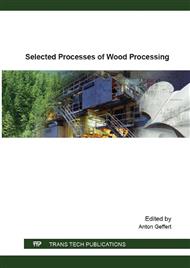[1]
J. Kubačková, J. Feranc, I. Hudec, Š. Šutý, M. Jablonský, J. Annus, J. Preťo, Antioxidant properties of lignin in rubber blends. Elastomery 17 (2013) 21-27.
Google Scholar
[2]
M. Jablonský, J. Kočiš, J. Šima, A. Ház, Characterization and comparison by UV spectroscopy of precipitated lignins and commercial lignosulfonates. Cell Chem Technol 49 (2015): 267-274.
Google Scholar
[2]
S. Suty, M. Jablonsky, M. Vrska, I. Surina, A. Haz, T. Lauko, M. Botkova, Lignin precipitation by polyelectrolyte Selected processes at the wood processing. X. International symposium september 11 – 13. (2013).
Google Scholar
[4]
L. Laurichesse, S. Avérous Chemical modification of lignins: Towards biobased polymers, Progress in Polymer Science 39 (2014) 1266–1290.
DOI: 10.1016/j.progpolymsci.2013.11.004
Google Scholar
[5]
C. Pouteau, P. Dole, B. Cathala, L. Averous, N. Boquillon N., Antioxidant properties of lignin in polypropylene, Polymer Degr. Stab., 81 (2003) 9-18.
DOI: 10.1016/s0141-3910(03)00057-0
Google Scholar
[6]
B. Verma, P. Hucl, R. N. Chibbar, Phenolic acid composition and antioxidant capacity of acid and alkali hydrolyzed wheat bran fractions, Food Chem 116 (2009) 947-954.
DOI: 10.1016/j.foodchem.2009.03.060
Google Scholar
[7]
E. Jakab, O. Fdix, F. Till, Thermal decomposition of milled wood lignins studied by thermogravimetry/mass spectrometry. Journal of Analytical and Applied Pyrolysis 1997; 40-41: 171.
DOI: 10.1016/s0165-2370(97)00046-6
Google Scholar
[8]
T. Hosoya, H. Kawamoto, S. Saka, Role of methoxyl group in char formation from lignin-related compounds, Journal of Analytical and Applied Pyrolysis 2009; 84: 79.
DOI: 10.1016/j.jaap.2008.10.024
Google Scholar
[9]
M. Jablonský, M. Botková, J. Adamovská, J., Prediction of content of methoxyl groups in lignin from ultimate analysis. Cell Chem Technol 49 (2015) 165-168.
Google Scholar
[10]
B. Kosikova, A. Gregorova, A. Osvald, J. Krajcovicova, Role of lignin filler in stabilization of natural rubber–based composites. Journal of Applied Polymer Science 103 (2007) 1226-1231.
DOI: 10.1002/app.24530
Google Scholar
[11]
I. Surina, M. Jablonsky, A. Haz, A. Sladkova, A. Briskarova, F. Kacik, J. Sima, Characterization of Non-wood Lignin Precipitated with Sulphuric Acid of Various Concentration. Bioresources 10 (2015) 1408-1423.
Google Scholar
[12]
X-F. Zhou, X-J. Lu, Structural characterization of kraft lignin for its green utilization. Wood Research 59 (2014) 583-591.
Google Scholar
[13]
E. Ungureanu, O. Urgureanu, A. M. Capraru, V. I. Popa, Chemical modification and characterization of straw lignin. Cell Chem Technol 43 (2009) 263-269.
Google Scholar
[14]
B. Monties, Biological variability of lignins. Cell Chem Technol 39 (2005) 341-367.
Google Scholar
[15]
J. Z., Mao, L. M. Zhang, F. Xu, Fractional and structural characterization of alkaline lignins from Carex meyeriana kunth. Cell. Chem. Technol. 46 (2012) 193-205.
Google Scholar
[16]
Haz, M. Jablonsky, L. Dubinyova, A. Sladkova, I. Surina, Thermal properties and size distribution of lignins precipitated with sulphuric acid, Wood Research 60 (2015) 375-384.
Google Scholar


